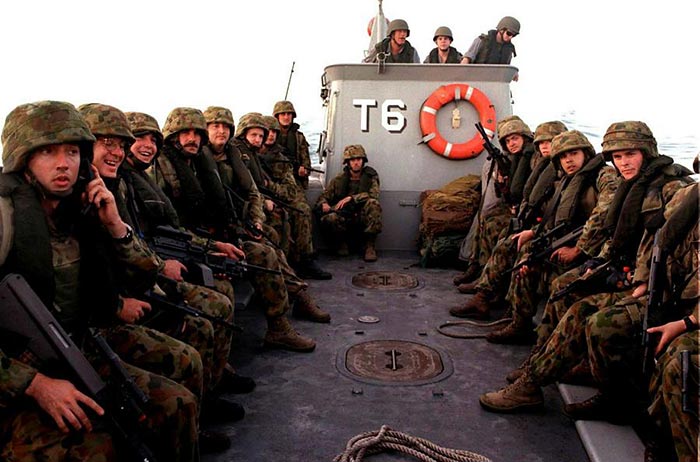Glen Braithwaite

Glen Braithwaite on the radio, on the extreme left of the landing craft, about to hit the beach at Suai, having launched from HMAS Tobruk. Photo: Courtesy Defence.
Glen Braithwaite was sitting in a gun pit in East Timor when he heard what he thought was gunfire.
It was 31 December 1999, and people around the world were bracing themselves for chaos as midnight approached.
There were fears computer systems would collapse and stop working at the turn of the century as the calendar switched over to January 2000.
“We were there for the Millennium,” Glen said.
"Half of my troops had the night off and some of us took a break from the command post and manned the guns to give the troops a break.
“So, on the night that everyone was worrying about the Y2K bug, and whether it would stop all our computers, we were in a gun pit in Suai, close to the Indonesian border...
“We heard gunfire and we thought, ‘Oh no, something is happening.’
“But it was just someone in the distance firing shots or setting off fireworks, likely to celebrate the New Year.
“But we didn’t know that at the time.”
A retired Australian Army engineer, Glen had deployed to East Timor in 1999 as part of the International Force for East Timor (INTERFET). The United Nations had mandated the multinational peacekeeping taskforce to address the humanitarian and security crisis, which had overrun East Timor following the independence referendum vote. He returned to East Timor in 2006 as part of Operation Astute following unrest between elements of the Timor-Leste Defence Force.
“I joined as a 17-year-old, and recently retired as a 50-year-old, so I have been an army officer most of my life,” Glen said.
“I started as a reservist when I was still in Year 12, but as soon as I finished Year 12, I went to Duntroon and then became an officer in the Royal Australian Engineers.
“I was posted to the 3rd Brigade, so we were the first ones into East Timor after the long peace.
“They said we were going to be deployed for 40 days, but it turned out to be six months…
“We were the first to go into Suai in the bottom part of East Timor, and we were some of the first people on the scene where the Suai Church massacre happened... The trauma of seeing the bloody stairwell of the church, and the charred remains where bodies had been burnt, those things stood out to me.
To read Glen’s full story visit The Australian War Memorial ‘s website.
Source: Claire Hunter, The Australian War Memorial, 18 November 2022.